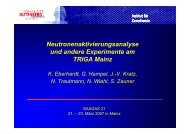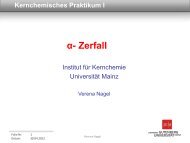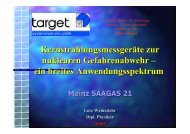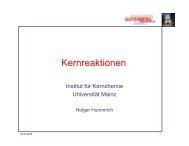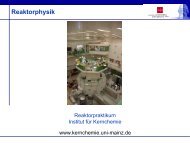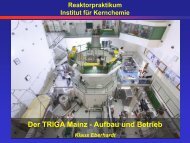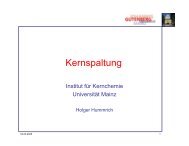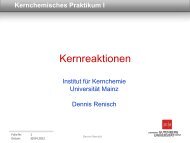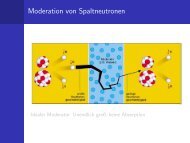jahresbericht 2007 - Institut für Kernchemie - Johannes Gutenberg ...
jahresbericht 2007 - Institut für Kernchemie - Johannes Gutenberg ...
jahresbericht 2007 - Institut für Kernchemie - Johannes Gutenberg ...
You also want an ePaper? Increase the reach of your titles
YUMPU automatically turns print PDFs into web optimized ePapers that Google loves.
Monte-Carlo simulations of the ultra-cold neutron transport in the test solid<br />
deuterium source at channel C of the TRIGA Mainz.<br />
Y.Sobolev 1,2 , I.Altarev 3 , A.Frei 3 , E.Gutsmiedl 3 , G.Hampel 1 , F.J.Hartmann 3 , W.Heil 2 , J.V.Kratz 1 ,<br />
Th.Lauer 1 , S.Paul 3 ,C. Plonka – Spehr 1 ,Yu.N.Pokotilovski 4 , N.Trautmann 1 , M.Urban 3 , N.Wiehl 1<br />
1 <strong>Institut</strong> für <strong>Kernchemie</strong>, Universität Mainz, D-55099 Mainz, Germany; 2 <strong>Institut</strong> für Physik, Universität<br />
Mainz, D-55099 Mainz, Germany; 3 Physik Department E18, Technische Universität München, D-<br />
85748 Garching, Germany; 4 Joint <strong>Institut</strong>e of Nuclear Research, Dubna, Russia<br />
At the beginning of 2006, ultra-cold neutrons<br />
(UCN) were obtained for the first time at the<br />
prototype UCN-source of the research reactor<br />
TRIGA Mainz [1]. The source is located at the<br />
tangential beam port C of the reactor. During<br />
<strong>2007</strong> many improvements were carried out to<br />
optimize the production and extraction of UCN.<br />
Finally, up to 200000 very- and ultra-cold<br />
neutrons were detected at 10 MJ reactor<br />
pulses [2]. Even more UCN are expected with<br />
the installation of a newly designed source at<br />
the radial beam port D in summer 2008. One<br />
significant improvement will be the higher<br />
neutron flux at this position directly in front of<br />
the reactor core.<br />
The source is based on a solid deuterium<br />
converter from which UCN are transported via<br />
a 5.5 m neutron guide to the detector. The<br />
efficient extraction of UCN from the converter<br />
and the transport via the neutron guides is a<br />
crucial factor. Therefore, we carried out Monte-<br />
Carlo simulations of the UCN-transmission<br />
from the source to the experiment.<br />
In these calculations, the following model was<br />
used: Solid deuterium in form of a cylinder of<br />
diameter 66 mm and thickness d is located<br />
next to the reactor core in a straight cylindrical<br />
stainless steel neutron guide with a length of<br />
3.5 m. The neutron guide is separated after a<br />
distance of 3.5 m from the converter by an<br />
aluminum foil (0.1mm thickness). Downstream<br />
follows the experimental part of the neutron<br />
guide containing bends of 45 and 90 degree as<br />
shown in Fig. 1:<br />
the mean free loss length for slow neutrons as<br />
parameter and also taking into account the<br />
wall-potential of solid deuterium which can<br />
reflect neutrons back inside the converter. For<br />
the calculation of the propagation of neutrons<br />
through the neutron guide, the influence of<br />
gravity and the dependence of different<br />
neutron guide parameters, such as diffuse<br />
reflection and losses of neutrons per collision<br />
due to absorption, were taken into account.<br />
The transmission through the separating<br />
aluminum foil as well as through the detector<br />
aluminum entrance window was simulated<br />
directly for each incident angle of entering<br />
neutrons using the known wall-potential of<br />
aluminum for reflection and refraction and<br />
neutron capture cross-section for losses. The<br />
comparison between the simulated and<br />
measured Time-of-Flight spectra after the<br />
reactor pulse is shown in Fig. 2:<br />
Fig. 2: Simulated and measured Time-of-Flight<br />
spectra of very- and ultra-cold neutrons after<br />
the reactor pulse.<br />
As final result we obtained a UCN-transmission<br />
of only 25 – 30% for velocities smaller than 6<br />
m/s. This shows the necessity to further<br />
improve the extraction and transmission of the<br />
UCN by polishing of the neutron guides and<br />
coating with materials of higher wall-potentials<br />
like Nickel or Diamond-like-Carbon.<br />
Fig. 1: Schematic view of the setup for the MC<br />
simulation.<br />
The production rate of UCN was obtained in<br />
accordance with [3] using MCNP calculations<br />
of the neutron flux at the converter position.<br />
UCN losses in deuterium were simulated using<br />
1. I.Altarev et. al., Jahresbericht Inst. f.<br />
<strong>Kernchemie</strong> 2005<br />
2. A.Frei et al., Eur.Phys.J.A34,119–<br />
127(<strong>2007</strong>)<br />
3. Z.Ch.Yu et al., Z.Phys. B62, 137-142<br />
(1986)<br />
- A5 -



